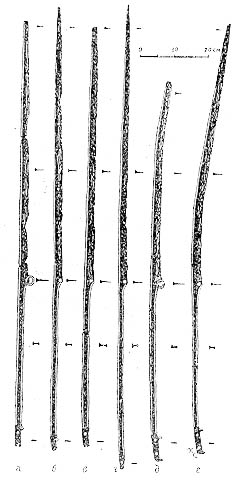Rhomphaia
The Rhomphaia was a close combat bladed weapon used by the Thracians as early as 400 B.C. It was a variant of the Dacian Falx. Most rhomphaias were polearms, featuring a straight or slightly curved single-edged blade attached to a pole that was considerably longer than the blade. Some rhomphaias had short handles that extended to only the length of the blade.
Although the rhomphaia was similar to the Falx, most archaelogical evidence suggests that rhomphaias were forged with straight or slightly curved blades, presumably to enable their use as both a thrusting and slashing weapon.
Technical Specifications
The blade itself was constructed of iron and used a triangular cross section to accommodate the single cutting edge with a tang of rectangular cross section. Length varied, but a typical rhomphaia would have a blade of approximately 60-80cm and a tang of approximately 50cm. From the length of the tang, it can be presumed that when attached to the hilt, this portion of the weapon would be of similar length to the blade.
Usage
Used almost exclusively by the Thracians, examples have been found dating from 300-400BC. As a weapon, the rhomphaia was feared (like the Falx) because of the cutting power afforded to it by the polearm like design. The rhomphaia forced the only documented change in Roman armour brought about by an encounter with a new weapon. After encountering the Falx in Dacia, the Romans added extra reinforcing bars to their helmets to protect against the powerful blows of these weapon. Also the Byzantines used the blade as well, although it most likely was used by a few units of foot soldiers dating somewheere between Byzantium's golden age of ~900-1071, and maybe even earlier. It was not mentioned as a weapon like the falx however, and Osprey Publishing, who wrote their book about the Byzantine army 800-1118, were stumped themselves as to what this weapon was. They assumed correctly that it was falx like, but it also could have been a sabre. Now it is revealed that it was indeed a falx-like weapon.
Differences from the falx
The rhomphaia's blade was straight or only slightly curved, while the falx's blade was significantly curved. Because its straighter blade facilitated a thrusting motion and an overhead or sidewards hacking motion, the rhomphaia could be used by tightly packed troops as a defensive weapon. However, the straighter blade limited the use of the cutting edge.
Rhomphaia in historical texts
Rhomphaia was first‘a spear’, later ‘a sword’ (Plutarch: Life of Aemilius Paulus 18; Eustathius, on Iliad verse VI 166; Hesychius; also Luke 2;35 and the Revelation of John of Patmos, several times.). In Latin, it has the forms:
- rumpia (Livy, Aulus Gellius, Ascon. ad Mil.)
- romphea (Isidore of Seville.),
- romphaea vel romfea (CGL 7, 212).
W. Tomaschek listed the Bulgarian. roféja, rufja ‘a thunderbolt’ and the Albanese. rrufë as derivatives of that word.
Rhomphaia was also preserved in modern Greek as rhomphaia ‘a big broad sword’. The Thracian rhomphaia contains the IE stem *rump- in the Latin rumpo, -ere ‘to break, to tear’.
